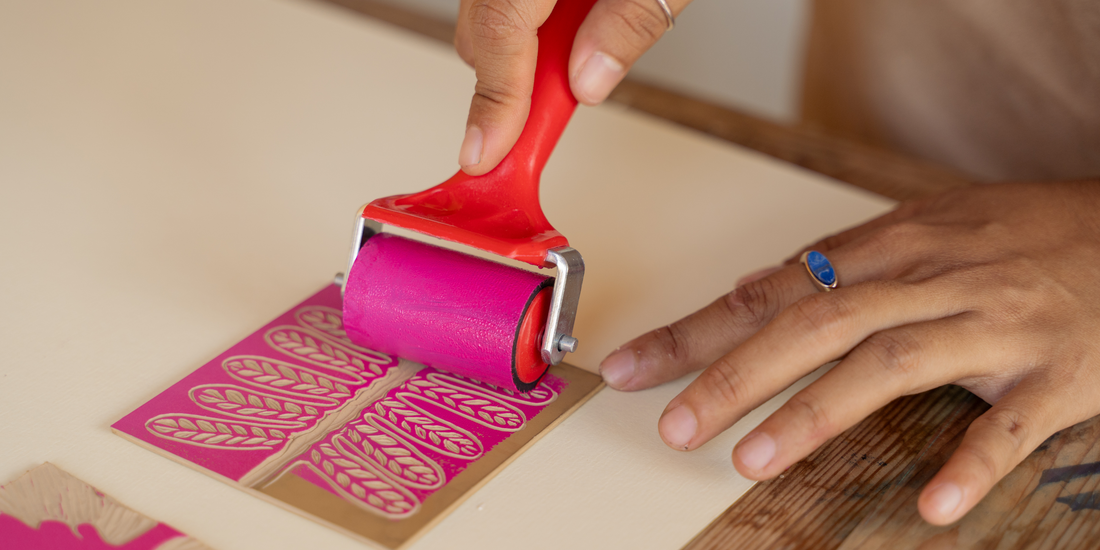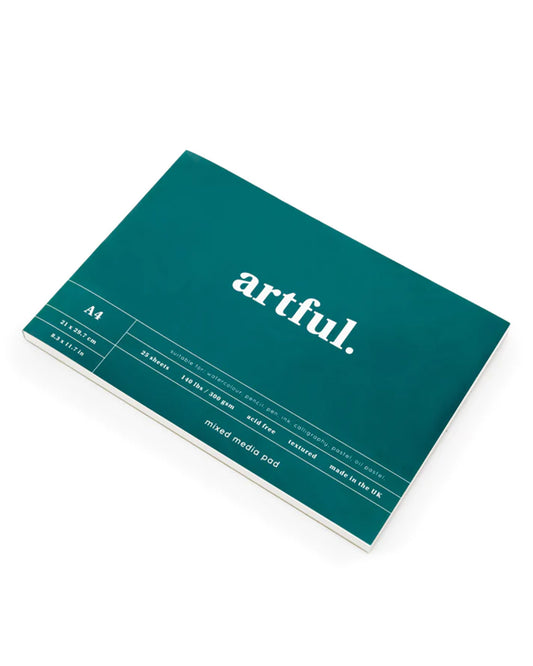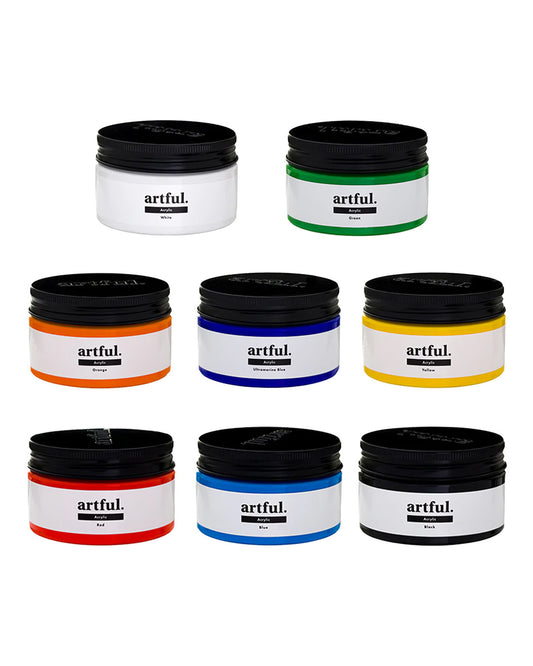Printmaking is all about transferring images from a template onto surfaces like paper or fabric, and it's not just about reproduction - it's a playground for artistic innovation.
From ancient handprints on cave walls to modern masterpieces, printmaking has evolved into a diverse array of techniques. Whether it's carving images into woodblocks, etching designs onto metal plates, or creating intricate stencils, each method brings its own flair to the canvas.
- What is printmaking?
Printmaking is a process which allows artists to transfer images from a matrix (or template) onto another surface, such as paper or fabric. Although it can be used as a way to reproduce work, printmaking is quite often used as a medium to create new and exciting works. As such, it is a very unique art form which mixes creativity and technical skill!
In its most basic form, printmaking has been around since prehistoric times when humans made prints by using their hands as stencils and placing them on cave walls. Traditional printmaking techniques include etching, engraving and woodcut but modern artists also use other methods such as screenprinting - we’ll dive into these later.
Throughout history, printmaking has served as an affordable way to communicate and share art, allowing text and images to be easily reproduced. But the Industrial Revolution was the real catalyst of mass print production, as new methods of printing (such as lithography) made reproducing images a lot easier, and quicker! Transport methods were also better, meaning more people could easily access newspapers, magazines and journals.
The speed at which printing was moving after the Industrial Revolution created an almost counter-effect, as some artists started to see the value in and specialness of prints made by hand. This culminated in the revival of older techniques such as etching, as artists started to revolt against mass production.
- Printmaking techniques
Relief:

The Great Wave off Kanagawa by Hokusai, Image from The MET
Relief printing is an umbrella term used to describe techniques in which a surface is cut away so the image appears on the raised surface. To put it plainly, the shapes you carve into the printing block will not show up on paper, as they won’t have ink on them! There are different types of relief printing, with the oldest one being woodblock. The woodblock process involves an image (or text) being carved into a wood plank. The ink is then rolled or dabbed onto the uncut parts and the inked block is pressed onto paper. The result is a mirror image of the design on the block. Other relief printing processes include monoprint, lino print, metal cut, some forms of collograph and traditional letterpress.
*Fun Fact:* The famous The Great Wave off Kanagawa print, which is still widely popular today, was originally created in 1831 by artist Hokusai using the woodblock process.
Intaglio:

Self Portrait in a Velvet Cap with Plume by Rembrandt, Image from the MET
The Intaglio printmaking method involves an image being cut onto the surface of a plate. The design is usually incised or cut onto the surface and covered with an indeed layer. The ink is then wiped clean from the plate but will remain on the incisions. The inked plate is then pushed through a press and transferred onto paper.
Intaglio processes include engraving (which involves crisp, fine lines being carefully incised into a plate), etching (which involves using acid to incise areas into a metal plate in order to hold the ink) and drypoint (which consists of scratching lines directly into the surface of the copperplate using a sharp, pointed tool).
*Fun Fact:* Self Portrait in a Velvet Cap with Plume by Rembrandt (1638) is one of the most famous examples of etching. Spanish artist Francisco Goya is also celebrated for his ethics which offer a window into societal problems in the late 18th and early 19th centuries.
Planographic:
Planographic printing covers a range of techniques in which the printing and non-printing areas of the plate are in a single place - which means you’ll be printing from a flat surface. The most popular example of planographic printmaking is lithography, in which a design is drawn onto a flat stone (or metal plate) using a special greasy ink. An acid solution is then applied over the surface, which makes the non-image areas ink-repellent. The surface is kept wet and paper is placed against the surface of the stone and run through a press. The final result will be a reversed version of the original drawing.
Offset Lithography is another planographic method, which involves printing the image onto an intermediate surface before the final sheet. The process is referred to as ‘offset’ because, unlike the standard lithography method, the paper never actually comes into contact with the stone! This means by using the offset lithography process, the image is reversed twice and will appear on the final sheet the same way around as on the stone/plate.
*Fun fact:* In the lithography process, areas of different colours can be applied to separate stones and overprinted onto the same sheet.
Stencil:

Marilyn Diptych by Andy Warhol
Stencil printing is a versatile technique used to reproduce images or designs onto various surfaces. As the name suggests, stencil printing involves the passing of ink through a stencil (or template) with open areas which will allow ink or paint to pass through onto the desired medium (e.g. paper, fabric). Screen Printing is a popular stencil printing method that uses a fine mesh screen stretched over a frame. The stencil is made by blocking off areas of the screen using a stencil film, paper, or emulsion. Ink is then forced through the open areas of the screen onto the material below, creating a printed image. Screen printing is widely used for printing on fabrics, paper, plastic, and other materials.
Another stencil technique is risograph printing, which combines aspects of screen printing and photocopying. It uses a machine that resembles a photocopier but works similarly to a screen printing process.
Mimeograph printing is an older method that dates back to the mid-20th century. It involves creating a stencil by cutting or perforating a thin wax-coated sheet. The stencil is placed on a rotating drum, and ink is forced through the cut or perforated areas onto paper as it passes beneath the drum.
And, lastly, aerography is a stencil printing method that uses compressed air to spray ink or paint onto a surface. The stencil is typically created by cutting out the desired image on a thin material such as paper or plastic. The airbrush is then used to spray the ink or paint over the stencil, allowing the image to be transferred accurately.
*Fun fact* Andy Warhol is one of the most famous printmaking artists ever. We used the screen printing technique to repeat a basic image and create endless variations of it by using different colours or even adding paint to the printed surface.
- Printmaking artists throughout history

Knight, Death and the Devil by Albrecht Dürer, Image from the MET
Printmaking is an art form spanning centuries and has been instrumental in sharing ideas throughout the world. Below, we explore some of the most notable printmaking artists from history and the incredible works they left behind.
Albrecht Dürer (1471-1528): A German artist widely regarded as one of the greatest printmakers of all time. Dürer's engravings and woodcuts revolutionised printmaking during the Renaissance. His most famous works include "Knight, Death and the Devil," "Melencolia I," and "Adam and Eve."
Rembrandt van Rijn (1606-1669): A Dutch master known for his exceptional etchings. Rembrandt's prints showcased his remarkable skill in capturing light and shadow, as well as his ability to convey emotions and intimate scenes. Notable works include "The Three Crosses," "Christ Preaching," and "The Hundred Guilder Print."
Pablo Picasso (1881-1973): While primarily known as a painter and sculptor, Picasso also made significant contributions to printmaking. He experimented with various printmaking techniques, including etching, aquatint, and linocut. Picasso's prints showcased his bold and innovative style, and notable examples include the “Vollard Suite" and "La Femme Qui Pieure”.
Andy Warhol (1928-1987): Warhol revolutionised printmaking in the 20th century. He made screen printing popular as an artistic medium, using it to create iconic images of celebrities, consumer products, and political figures. His prints, such as "Marilyn Diptych" and "Campbell's Soup Cans," became synonymous with Pop Art.
Katsushika Hokusai (1760-1849): A Japanese ukiyo-e artist recognized for his woodblock print series "Thirty-Six Views of Mount Fuji," which includes his most famous work, "The Great Wave off Kanagawa." Hokusai's prints depicted various aspects of Japanese culture and landscapes with meticulous detail.
- History of Modern Printmaking

A Bigger Splash by David Hockney, Image by TATE
In the realm of modern art, printmaking continues to captivate and inspire artists with its versatility and expressive potential. From the evocative works of Cecil Collins to the bold and dynamic prints of David Hockney, let's explore the remarkable contributions of some influential artists.
Cecil Collins (1908-1989) was a British artist known for his mystical and symbolic prints. His works often conveyed a sense of spirituality, exploring themes of love, harmony, and the human spirit. Collins' ethereal and dreamlike prints, such as "The Sleeping Fool" and "The Promise," invite viewers to contemplate the deeper aspects of existence.
Anthony Burrill is a contemporary British artist renowned for his vibrant and typographic prints. His distinct style combines bold lettering with powerful messages, often employing phrases like "Work Hard and Be Nice to People" and "I Like It. What Is It?" Burrill's prints, characterised by their simplicity and optimism, have gained popularity for their ability to inspire and uplift.
Patrick Caulfield (1936-2005) was a British artist associated with the Pop Art movement. His prints often depicted everyday objects and interiors with bold outlines and flat colours, creating a sense of visual intrigue and irony. Caulfield's iconic works, such as "After Lunch" and "Pottery," showcased his meticulous attention to detail and his ability to infuse ordinary scenes with a sense of mystery and depth.
David Hockney, a renowned British artist, made significant contributions to modern printmaking. He explored various techniques such as etching, lithography, and digital prints, always pushing the boundaries of the medium. Hockney's prints are characterised by their vibrant colours, intricate compositions, and his ability to capture the essence of landscapes and people. Notable examples include "A Bigger Splash" and "The Arrival of Spring."


